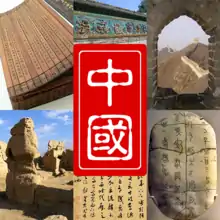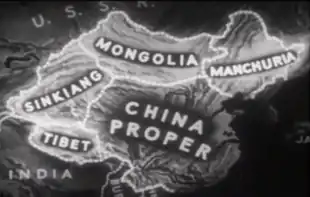Greater China
Greater China is an informal geographical area that shares commercial and cultural ties with the Han Chinese people.[1][2][3] The notion of "Greater China" refers to the area that usually encompasses Mainland China, Hong Kong, Macau, and Taiwan in East Asia, places where the majority are culturally and ethnically Han Chinese.[4][5][6] Some analysts may also include places which have predominantly ethnic Chinese population such as Singapore. The term can be generalised to encompass "linkages among regional Chinese communities".[7][8]
| Greater China | |||||||||||||||||||||
|---|---|---|---|---|---|---|---|---|---|---|---|---|---|---|---|---|---|---|---|---|---|
 | |||||||||||||||||||||
| Chinese name | |||||||||||||||||||||
| Traditional Chinese | 大中華 | ||||||||||||||||||||
| Simplified Chinese | 大中华 | ||||||||||||||||||||
| |||||||||||||||||||||
| Vietnamese name | |||||||||||||||||||||
| Vietnamese alphabet | Đại Trung Hoa | ||||||||||||||||||||
| Chữ Hán | 大中華 | ||||||||||||||||||||
| Korean name | |||||||||||||||||||||
| Hangul | 중화권 | ||||||||||||||||||||
| Hanja | 中華圈 | ||||||||||||||||||||
| Japanese name | |||||||||||||||||||||
| Kanji | 中華圏 | ||||||||||||||||||||
| Kana | ちゅうかけん | ||||||||||||||||||||
| Kyūjitai | 中華圈 | ||||||||||||||||||||
Usage
Multinational corporations frequently use the term to name their regional headquarters. For example, P&G uses it to name its regional headquarter in Guangzhou that also operates in Hong Kong and Taipei, Taiwan.[9] Apple uses it for its regional headquarters in Shanghai.[10][11]
The term is often used to avoid invoking sensitivities over the political status of Taiwan.[12]
The term has also been used in reference to Chinese irredentism in nationalist contexts, such as the notion that China should reclaim its "lost territories" to create a Greater China.[13][14]
History


The term has been used for a long time, but with differing scopes and connotations.
In the 1930s, George Cressey used it to refer to the entire Chinese Empire, as opposed to China proper.[15] Usage by the United States on government maps in the 1940s as a political term included territories claimed by the Republic of China that were part of the previous Qing Empire, or geographically to refer to topographical features associated with China that may or may not have lain entirely within Chinese political borders.[15]
The concept began to appear again in Chinese-language sources in the late 1970s, referring to the growing commercial ties between the mainland and Hong Kong, with the possibility of extending these to Taiwan, with perhaps the first such reference being in a Taiwanese journal Changqiao in 1979.[15]
The English term subsequently re-emerged in the 1980s to refer to the growing economic ties between the regions as well as the possibility of political unification.[15] It is not an institutionalized entity such as the EU, ASEAN, or AU. The concept is a generalization to group several markets seen to be closely linked economically and does not imply sovereignty.[12] The concept does not always include Taiwan, for instance Cisco uses "Greater China and Taiwan" to refer to the market.[16]
See also
References
- "Pact row could harm Greater China economic integration: ANZ". Focus Taiwan. 2 April 2014. Retrieved 6 November 2018.
- MTV Channels In Southeast Asia and Greater China To Exclusively Air The Youth Inaugural Ball Archived 22 May 2009 at the Wayback Machine - MTV Asia
- 1 June 2008, Universal Music Group realigns presence in Greater China Archived 14 December 2017 at the Wayback Machine, Television Asia
- William, Yat Wai Lo (2016). "The concept of greater China in higher education: adoptions, dynamics and implications". Comparative Education. 52: 26–43. doi:10.1080/03050068.2015.1125613.
This term can be narrowly defined as referring to a geographic concept that consists of the People's Republic of China, the Republic of China, the Hong Kong Special Administrative Region and the Macau Special Administrative Region, where ethnic Chinese comprise the majority of the population. In this sense, the term is used to describe the ethnic and the associated political, economic and cultural ties among these Chinese societies (Harding 1993; Cheung 2013).
- "Apple overtakes Lenovo in China sales". Financial Times. 18 August 2011. Archived from the original on 27 November 2011. Retrieved 19 November 2011.
- "《路透晚报》4月29日日间新闻摘要(大中华区)". 路透中文网 reuters. 29 April 2019.
- William, Yat Wai Lo (2016). "The concept of greater China in higher education: adoptions, dynamics and implications". Comparative Education. 52: 26–43. doi:10.1080/03050068.2015.1125613.
However, some analysts see the Greater China concept as a way to summarise 'the linkages among the fair-flung international Chinese community', thereby incorporating Singapore and overseas Chinese communities in their usage of the term (Harding 1993, 660; also see Wang 1993).
- Harding, Harry (December 1993). "The Concept of "Greater China": Themes, Variations and Reservations*". The China Quarterly. 136: 660–686. doi:10.1017/S030574100003229X. ISSN 1468-2648. S2CID 154522700.
- "P&G in Greater China". www.pgcareers.com. Retrieved 16 March 2020.
- "Isabel Ge Mahe named Apple's managing director of Greater China". Apple Newsroom. Retrieved 16 March 2020.
- Mickle, Andrew Dowell and Tripp (14 March 2020). "Apple Closes All Its Stores Outside China Over Coronavirus". Wall Street Journal. Retrieved 16 March 2020.
- Aretz, Tilman (2007). The greater China factbook. Taipei: Taiwan Elite Press. ISBN 978-986-7762-97-9. OCLC 264977502. Archived from the original on 31 January 2009.
- Tseng, Hui-Yi (2017). Revolution, State Succession, International Treaties and the Diaoyu/Diaoyutai Islands. Cambridge Scholars Publishing. p. 66. ISBN 9781443893688.
- Kim, Samuel S. (1979). China, the United Nations, and World Order. Princeton University Press. p. 43. ISBN 9780691100760.
- Harding, Harry (December 1993). "The Concept of 'Greater China': Themes, Variations and Reservations". The China Quarterly. 136 (136, Special Issue: Greater China): 660–686. doi:10.1017/S030574100003229X. S2CID 154522700.
- "The Rundown: Pegatron's Tesla Ambitions, Tech Sector Bonuses, and Cisco's New Software Center". topics.amcham.com.tw. Taiwan Topics. 18 January 2021. Retrieved 18 January 2021.